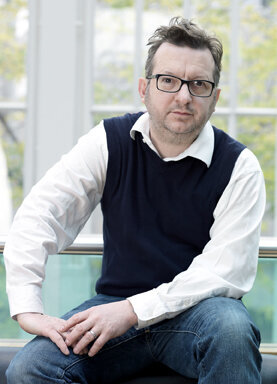
Enter the Vortex
Beginning with two works looking back to January's 'Solitude & Suffrage', this program ultimately dives into the mesmerizing sound world of French Spectral music.
Program
| Angélica Negrón | La bicicleta de cristal (2003) 5’ |
| George Nickson, vibraphone |
| Mark-Anthony Turnage | An Invention on 'Solitude' (1999) 8’ |
| Bharat Chandra, clarinet Samantha Bennett & Mia Laity, violins Rachel Halvorson, viola Natalie Helm, cello |
| Philippe Hurel | Loops 2 (2002) 10’ |
| George Nickson, vibraphone |
| Philippe Manoury | Last (1997) 8’ |
| Calvin Falwell, bass clarinet George Nickson, marimba |
| Gerard Grisey | Périodes (1974) 17’ |
| Betsy Hudson Traba, flute Calvin Falwell, clarinet Harold Van Schaik, trombone Samantha Bennett, violin Rachel Halvorson, viola Natalie Helm, cello John Miller, bass George Nickson, conductor |
Angélica Negrón
Puerto Rican-born composer and multi-instrumentalist Angélica Negrón writes music for accordions, robotic instruments, toys and electronics as well as chamber ensembles and orchestras. Her music has been described as “wistfully idiosyncratic and contemplative” (WQXR/Q2) and “mesmerizing and affecting” (Feast of Music) while The New York Times noted her “capacity to surprise” and her “quirky approach to scoring”. Angélica has been commissioned by the Bang on a Can All-Stars, loadbang, MATA Festival, Brooklyn Youth Chorus, Sō Percussion, the American Composers Orchestra, and the New York Botanical Garden, among others. Her music has been performed at the Kennedy Center, the Ecstatic Music Festival, EMPAC, Bang on a Can Marathon and the 2016 New York Philharmonic Biennial and her film scores have been heard numerous times at the Tribeca Film Festival. She has collaborated with artists like Sō Percussion, The Knights, Face the Music, and NOVUS NY, among others and is a founding member of the tropical electronic band Balún. Angélica holds a Master’s degree in music composition from New York University and pursued doctoral studies at The Graduate Center (CUNY) under the guidance of Tania León. She's a teaching artist for New York Philharmonic's Very Young Composers Program working with young learners on creative composition projects. Upcoming premieres include works for the LA Philharmonic, Dallas Symphony Orchestra and National Symphony Orchestra, San Francisco Girls Chorus, and NY Philharmonic Project 19 initiative. Negrón continues to perform and compose for film.
Mark-Anthony Turnage (b. 1960)
A composer of international stature, Mark-Anthony Turnage (b. 1960) is indisputably among the most significant creative figures to have emerged in British music of the last three decades. His first opera, Greek, established Turnage's reputation in 1988 as an artist who dared to forge his own path between modernism and tradition by means of a unique blend of jazz and classical styles.
Three Screaming Popes, Kai, Momentum and Drowned Out were created during his time as Composer in Association in Birmingham with Simon Rattle between 1989 and 1993, followed by Blood on the Floor, his unique score written for the distinguished jazz musicians John Scofield and Peter Erskine, and Martin Robertson.
His opera, The Silver Tassie, was premiered by English National Opera in 2000, winning both the South Bank Show and the Olivier Awards for Opera. Anna Nicole played to sold–out houses at Covent Garden in 2011 and has also been staged in Dortmund, New York and Nuremburg, while his opera for family audiences Coraline, was staged by The Royal Opera at the Barbican Theatre in 2018, travelling on to Freiburg, Lille, Stockholm and Melbourne. Turnage has written ballet scores for both Sadler's Wells (Undance) and the Royal Ballet (Trespass and Strapless).
Turnage has been resident composer with the Chicago Symphony Orchestra, BBC Symphony Orchestra and London Philharmonic Orchestra. Collaborations with the London Symphony Orchestra have included two new works, Speranza premiered under Daniel Harding in 2013 and Remembering which Simon Rattle conducted in London and with the Berlin Philharmonic Orchestra in 2017.
A Piano Concerto for Marc-André Hamelin and a drumkit concerto featuring jazz drummer Peter Erskine were premiered in 2013. Recent chamber works have included Contusion written for the Belcea Quartet and Shroud for the Emerson Quartet. Other recent scores include Frieze conducted by Vasily Petrenko at the BBC Proms, Passchendaele commemorating the centenary of the outbreak of the First World War, the double violin concerto Shadow Walker written for soloists Vadim Repin and Daniel Hope, his setting of Ukrainian texts for soprano and orchestra, Testament, with first performances conducted by Kirill Karabits, and the song cycle Refugee written for tenor Allan Clayton and the Britten Sinfonia. His 60th birthday is celebrated in 2020.
Much of Turnage's music is recorded on Decca, Warner Classics, Chandos and the LPO and LSO labels, while Scorched, on Deutsche Grammophon, was nominated for a Grammy. Turnage is Research Fellow in Composition at the Royal College of Music, and is published by Boosey & Hawkes. He was awarded a CBE in the 2015 Queen's Birthday honours.
Reprinted by kind permission of Boosey & Hawkes
Philippe Hurel (b. 1955)
Philippe Hurel studied musicology at the Université de Toulouse from 1974-79 and composition with Betsy Jolas and Ivo Malec at the Conservatoire National Supérieur de Musique de Paris from 1980-83. He also had private studies in musical computer science with Tristan Murail in Paris in 1983. His honors include the Pensionnaire à la Villa Médicis à Rome (1986-88), the Förderpreis der Siemens-Stiftung in Munich 1995, for Six miniatures en trompe l'œil, the Prix des Compositeurs from SACEM (2002), and the Prix de la Meilleure Création de l'Année from SACEM 2003, for Aura. Mr. Hurel is also active in other positions. He worked as a music researcher at IRCAM in 1985-86 and 1988-89. He taught composition at IRCAM from 1997-2001. He also served as composer-in-residence to both the Arsenal de Metz and the Philharmonie de Lorraine from 2000-02. With Pierre André Valade he founded the new music ensemble Court-circuit in 1990 and has since served as its artistic director. Since 2013 he teaches composition at the Conservatoire national supŽrieur de musique et de danse de Lyon.
His music has been performed by numerous orchestras and ensembles and by conductors such as by Pierre Boulez, David Robertson, Ludovic Morlot, Tito Ceccherini, Jonathan Nott, Esa Pekka Salonen, Kent Nagano, Pierre-André Valade, François Xavier Roth, Christian Eggen, Lorraine Vaillancourt, Reinbert de Leeuw, Bernard Kontarsky…
After his opera Les pigeons d’argile (libretto by Tanguy Viel) premiered at the Capitole de Toulouse, his cycle Traits for violin and cello was premiered the same year in Paris by Alexandra Greffin-Klein et Alexis Descharmes. In 2015 his orchestral cycle Tour à tour was premiered at Radio France/Festival Manifeste/Ircam by the Orchestre Philharmonique de Radio-France conducted by Jean Deroyer. Pas à pas, commissioned by Ernst von Siemens music Foundation has been premiered the same year at the Biennale di Venezia by Ensemble Recherche.
In march 2017 Arditti Quartet premiered Entre les lignes (2016-17) at the Wittener Tage für Neue Kammermusik in Germany and in october 2018, Diotima Quartet premiered D'autre part (2017) at the Théâtre d’Orléans. Les Trois études pour Atlanta (2017), for flute and percussion was premiered in october 2017 in Atlanta. The concerto for clarinet and orchestra, Quelques traces dans l'air (2017-18) was performed in world premiere in june 2018 by Jérôme Comte, clarinet, and Johnannes Stockhammer conducting the Philharmonisches Orchester des Staatstheaters Cottbus (commission of Cootbus orchester, Orchestre Régional de Normandie and Buffet Crampon). In december 2018, Les Percussions de Strasbourg gave the Premiere of Ritual Trio for three percussionists (2018). He is now composing a string quartet with electronics for Tana and Ircam.
Editions Billaudot publishes his music written between 1981-96 and Éditions Lemoine publishes his music written since 1997.
Loops 2 (2002)
I wrote earlier about Loops I for flute that "the sound of the flute and its techniques are of less importance than the transformation procedure at work. The principle of the style of the piece is contained in the title which, when "looped", creates its own alliteration, and this spirit will colour a whole series of pieces based on the same principle. I start with little rhythmic motifs that are repeated and transformed as they progress. In fact, they are simple formulas which, by adding or taking away from themselves, end up creating further loops. "In this new Loops, written at the request of the Clermont-Ferrand International Vibraphone Competition, I have added an extra level to the principle of looping. The piece is so constructed that the process of cell transformation always brings you back to the motif announced at the outset. Although the music may seem to be undergoing perpetual transformation because of the morphing process, the listener will nevertheless feel it is going round in circles, since each long procedure brings you back to the starting point, like the little local loops that you can hear throughout the piece. As the work was intended to be used for an advanced-level vibraphone competition, I thought about introducing more difficult playing techniques than in Loops I for flute. Although I had no desire to use the instrument in ways not intended for it, I did want the performer to get to grips with a variety of techniques in a virtuoso context. For example, the piece ends with a long section in chords, which on a compositional level cannot be justified. This section - like other, very different sections in the work - acts as a "study" and involves the performer in specific technical study. Despite which, Loops II remains a very playful piece full of rhythmic energy, and I wrote it in a spirit of great pleasure and jubilation. It constitutes another stage of my work on percussion, and on the vibraphone in particular, which was begun in 1996 with ...à mesure, where the vibraphone plays a dominant role, and continued in 1999 and 2000 with the Tombeau in memoriam Gerard Grisey and the Quatre variations for percussion and ensemble, in which the vibraphone takes on the role of a concerto soloist.
-Philippe Hurel
Philippe Manoury (b. 1952)
Philippe Manoury studied at the École Normale and at the Paris Conservatory. A pupil notably of Max Deutsch, Michel Philippot, Ivo Malec, Yves-Marie Pasquet and Claude Ballif, he also studied computer-assisted composition with Pierre Barbaud. A revelation to the public at the age of 22 with Cryptophonos for piano, his earliest references were the works of Karlheinz Stockhausen, Pierre Boulez and Iannis Xenakis. A researcher at Ircam, he worked in collaboration with Miller Puckette on instrument/machine interactivity and became a pioneer in the research into and the development of real-time electronic music.
A teacher at the Lyons Conservatory (1987-1997), the University of San Diego (2004-2012), he was subsequently appointed composition teacher at the Académie Supérieure de la Haute École des Arts du Rhin in Strasburg. In 2015 he founded his own composition academy as part of the festival Musica (Strasburg) and in 2017 he was guest teacher for the Chaire Annuelle de Création Artistique at the Collège de France.
His output covers all genres, with or without electronics: Zeitlauf for chorus, ensemble and tape (1982), first performed by the Groupe Vocal de France and the Ensemble Intercontemporain; 60e Parallèle (1996), opera premiered at the Théâtre du Châtelet; K… (2001), commissioned by Bastille Opera; La frontière, chamber opera (2003); On-iron for vocal quartet, percussion, chamber choir, real-time electronics and video (2005); La nuit de Gutenberg, opera premiered at the Opéra National du Rhin for the festival Musica 2011 and for which Manoury was consecrated ‘Composer of the Year’ at the Victoires de la Musique 2012; Echo-daimonon, concerto for piano, electronics and orchestra (2012), first performed by Jean-Frédéric Neuburger and the Orchestre de Paris; Le temps, mode d’emploi for 2 pianos and electronics (2014), first performed at the Wittener Tage für neue Kammermusik; Ring (first part of the trilogy Köln) for spatialised orchestra (2016); Kein Licht (2017), first French performance at the Festival Musica.
Last (1997)
Last, for bass clarinet and marimba was written for Armand Angster and Emmanuel Séjourné. These two instruments, which are about as different as could be, find a common ground around figures and playing styles that answer back and forth, from one instrument to the other. The work begins with a bass clarinet recitative that will be interrupted several times by contrasting elements. This recitative serves as the basis for the whole work and reappears as a recurrent form. The middle section, made up of dots and lines, requires great virtuosity on behalf of the two instrumentalists.
- Philippe Manoury
Gerard Grisey (1946-1998)
Gérard Grisey was born in Belfort on June 17th, 1946. He studied at the Trossingen Conservatory in Germany from 1963 to 1965 before entering the Conservatoire National Supérieur de Musique in Paris. Here he won prizes for piano accompaniment, harmony, counterpoint, fugue and composition (Olivier Messiaen’s class from 1968 to 1972). During this period, he also attended Henri Dutilleux’s classes at the Ecole Normale de Musique (1968), as well as summer schools at the Accademia Chigiana in Siena (1969), and in Darmstadt with Ligeti, Stockhausen and Xenakis in 1972.
He was granted a scholarship by the Villa Medici in Rome from 1972 to 1974, and in 1973 founded a group called L’Itinéraire with Tristan Murail, Roger Tessier and Michael Levinas, later to be joined by Hugues Dufourt. Dérives, Périodes and Partiels were among the first pieces of spectral music.
In 1974-75, he studied acoustics with Emile Leipp at the Paris VI University, and in 1980 became a trainee at the I.R.C.A.M. In the same year he went to Berlin as a guest of the DAAD (Deutscher Akademischer Austausch Dienst), and afterwards left for Berkeley, where he was appointed professor of theory and composition at the University of California (1982-1986).
After returning to Europe, he has been teaching composition at the Conservatoire National Supérieur de Musique in Paris since 1987, and holds numerous composition seminars in France (Centre Acanthes, Lyon, Paris) and abroad (Darmstadt, Freiburg, Milan, Reggio Emilia, Oslo, Helsinki, Malmö, Göteborg, Los Angeles, Stanford, London, Moscow, Madrid, etc.)
Among his works, most of which were commissioned by famous institutions and international instrumental groups, are Dérives (1973-1974), Jour, contre-jour (1978-1979), Tempus ex Machina (1979), Les Chants de l’Amour (1982-1984), Talea (1986), Le Temps et l'Ecume (1988-1989), Le Noir de l'Etoile (1989-1990), L’Icône paradoxale (1993-1994), Les Espaces Acoustiques (1974-1985 - a cycle consisting of six pieces), Vortex Temporum(1994-1996), Quatre chants pour franchir le seuil (1997-1998).
Gérard Grisey died in Paris on 11 November 1998.
Périodes (1974)
Gerard Grisey’s Les espaces acoustiques is one of the seminal works of the spectral music school. “Everything began with Périodes,” said Grisey in an interview with Guy Lelong. “From a formal point of view, this piece consists of a succession of episodes, in the last of which I experimented for the first time with a technique that seemed to me in need of development. I had analyzed, with the help of a spectrogram, the sound of the trombone’s E and created its main components (the fundamental and its harmonics) with the instruments of Périodes. That opened my eyes to a new way of harmonic thinking and which I later called “instrumental synthesis.” I then had to write a sequel, and this turned out to be Partiels for 18 musicians (1975) which includes the instruments of Périodes. Then I finally decided to compose a whole cycle that would begin with a piece for solo instrument and finish with a large orchestra. As the viola played a prominent role in Périodes, the solo piece had to be written for this instrument, and it was Prologue for solo viola.”
There are three kinds of moments in Périodes, analogous to human breathing: states of inhaling, exhaling and resting are translated aurally into moments of dynamic and growing tension, dynamic and progressive relaxation, and static periodicity. The periodicity of the piece creates a distinct weight, as it turns in on itself in repetitive circles, until a new germ surfaces and spurs on a new energy and the evolution of a new thread. The cyclic nature of Périodes is not meant to affect synthetic accuracy. Instead, the cycles are more organic, or “blurred” like our own heartbeats, like our own walking paces, rhythmic but with a degree of human fluctuation.
Special Thanks To:
Sam Nelson
Greg Chestnut
First Congregational Church
Taylor Rothenberg-Manley
Hojoon Kim
Board of Directors
George Nickson: Chair and co-artistic director
Samantha Bennett: Vice-chair and co-artistic director
Justin Vibbard: Secretary
Eric Dean: Treasurer
Brian Boyd
Linda Z. Buxbaum
Stephen Fancher
Joan Golub
Pat Michelsen
Joe Seidensticker






